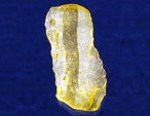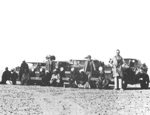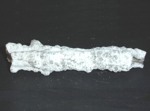Desert Glass / Lechatelierite / Libyanite Info
back to Desert Glass
 |
| Tutankhamun Pendant * |
 |
| Stone Age Blade * |
Lechatelierite was even used as tools since prehistoric times (middle paleolithic, neolithic), recognizable on the chipped edges of such tools, e.g. arrowheads and blades. Some thousand years ago, the Libyan desert was a savannah with a lot of different huntable animals!
 |
| 1934 Expedition * |
In December 1934, P.A. Clayton organized a special expedition to the lechatelierite area * at the Egyptian part of the Libyan desert, at 25°30'E 25°30'N, north of the Gilf Kebir plateau. He was joined by L.J. Spencer (Keeper of Minerals at the British Museum) and other mineralogists. They discovered that lechatelierite was spread over an area of appr. 6,500 km2.
* Photo: © www.egyptarchive.co.uk, Jon Bodsworth.
* Photo: © www.topgeo.de, Dr. Petr Zajicek.
* Photos: © www.fjexpeditions.com, Fliegel Jezerniczky Expeditions. Original source: Peter Clayton: "Desert Explorer" (1998)
 |
| Fulgurite * |
 |
| Trinitite * |
It may be the result of high pressure shock metamorphism of the quartz sand during the impact, having ejected melted, glassy material called tektites, composed of almost pure SiO2. The "fission track" dating method [Storzer & Wagner (1977)] shows an age of appr. 29 million years.
Lechatelierite can also be formed by the high temperature melting of quartz sand grains during a lightning strike, resulting in a tube of melted sand, silica glass. This is called fulgurite.
Last but not least lechatelierite can develop from nuclear bomb explosions over a sandy ground: The artificial material "trinitite" was "produced" in course of the first nuclear bomb test explosion at "Trinity Flats" in New Mexico on 16 July 1945.
* Photo: © António Manuel Ináçio Martins.
* Photo: © www.uraniumminerals.com, Paul Schumacher.
Resources
Today we know that lechatelierite is concentrated in two areas of the Libyan desert: an oval-shaped (130 x 50 km, major axis: NNW - SSE) and a circular one (appr. 50 km in diameter). Probably two meteorites in tandem hit the earth.
Lechatelierite can be found in sand-free corridors between the dunes. It lies on the surface or is partly embedded. All lechatelierites have been pitted or smoothed by sand-blast.
Color and Transparency
Lechatelierite is transparent to translucent. It occurs in different colors: colorless, white, grey, light green or yellowish. It can contain bubbles, light or dark brown beads or small cristobalite crystals.
The size of the found lechatelierite varies from less than 50 g to more than 25 kg.
More informations: © www.cs.sandia.gov, Mark Boslough.